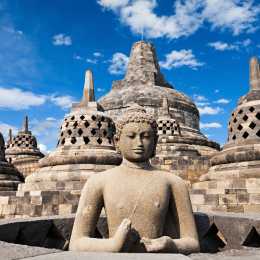A visit to Yogyakarta is incomplete without visiting the magnificent temples of Borobudur and Prambanan. Here we get the opportunity to see Buddhist and Hindu temples on the same day, which is somewhat unique, being that you don’t usually see them in that close proximity. These temples are popular and attract thousands of visitors each day. And so we chose to visit them at sunrise, in order to try and see them with fewer people around. Here’s how to visit Borobudur and Prambanan temples.
THIS POST MAY CONTAIN COMPENSATED AND AFFILIATE LINKS MORE INFORMATION IN OUR DISCLAIMER
BEST WAY TO VISIT
Take a Sunrise Tour of Borobodur
Borobodur at sunrise is spectacular, and shouldn’t be missed, this tour takes you to Borobodur for sunrise, and then also visits the Hindu temple of Prambanan and the Merapi Volcano – its an excellent value day out!
Borobodur
This is Borobodur, at sunrise.
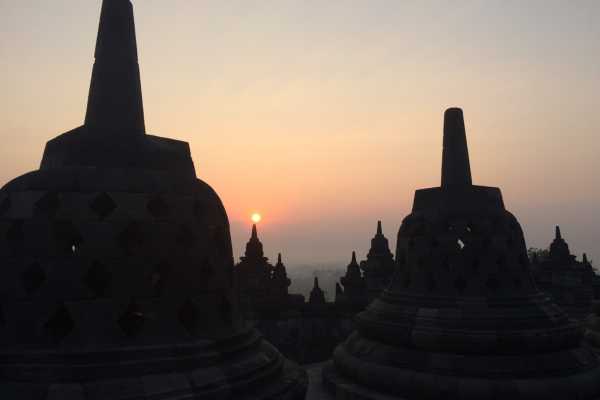
Sunrise at Borobodur
It’s an expensive sunrise, being that we took a tour from our hostel, the Casa de Raffles in Yogyakarta (Jogya to the locals), and that the ticket to get into this UNESCO World Heritage Site for sunrise is 380,000 IDR.
No, we don’t know why the prices are quoted differently, but they are EVERYWHERE. Regular ticket = dollars, sunrise ticket = rupiah. But of course, you pay in rupiah, which is 270,000 IDR.
Our sunrise ticket gives us early access, from 04:30 – and while the sun doesn’t rise at that time, it does give you the chance to get in position to see it rise from your perch on the Buddhist monument.
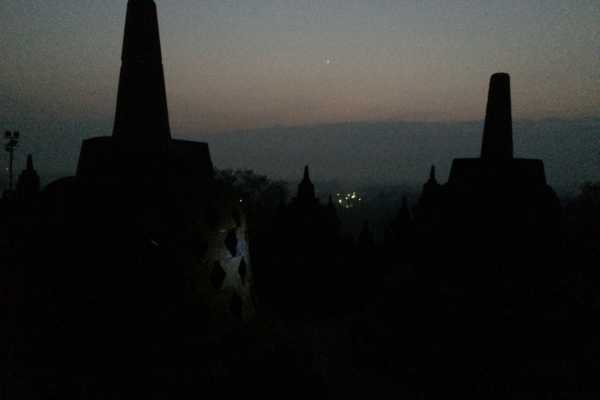
So, we got up at 03:45 and now we’re 40km northwest of Jogja.
PRACTICAL TRAVEL TIPS
- 🛡️ Get Travel Insurance: Civitatis includes medical expenses, repatriation, theft, luggage delays. No deductibles or upfront payments. Get a quote here.
- 🛏️ Sea view? Laundry? Private bath? Book a Room.
- 🔌 Be ready for the plug, socket & power situation.
- 📶 Internet, maps and data on the go. eSims for Travel
History of Borobodur
The name Borobodur is derived from Sanskrit and means Buddhist Monastery on the Hill. This spectacular Buddhist temple was built somewhere between AD 750 and AD 850 by the Sailendra dynasty with more than two million stone blocks. That’s nearly 60,000 cubic meters of stone and 300 years before Angkor Wat was built.
Buddhism in the area declined, power shifted further east on Java and volcanoes erupted, covering it in layers of volcanic ash. It wasn’t until 1815 when Sir Stamford Raffles was governing Java (he was here before he went to Singapore, which he founded in 1819) that the site was cleared.
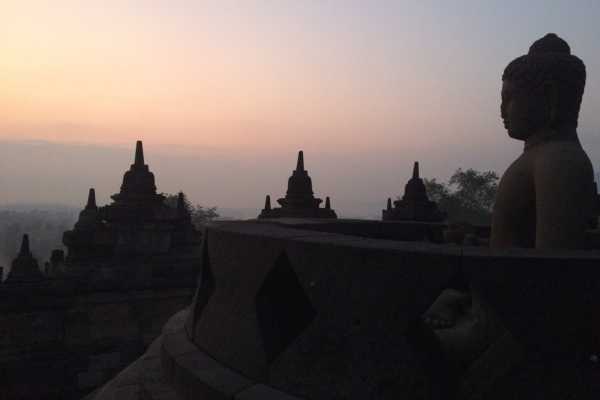
Restoration of Borobodur
The Dutch were the first to tackle restoration, giving away cartloads of “souvenirs” to a visiting Siamese king in 1896. They started restoring the monument from 1907 until 1911. UNESCO got involved and a huge project between 1973 and 1983 stabilized the monument, which was granted World Heritage Status in 1991.
Borobodur is tiny.
The temple is tiny in comparison to other monuments we have seen, despite being the world’s largest Buddhist monument. There’s a 118m x 118 m base, then six square terraces topped by three circular ones. There are four staircases leading up through gateways to the top. The pilgrims walk (clockwise), from the bottom, around each terrace is 5 km long. We manage most of it, apart from the small areas that are closed.
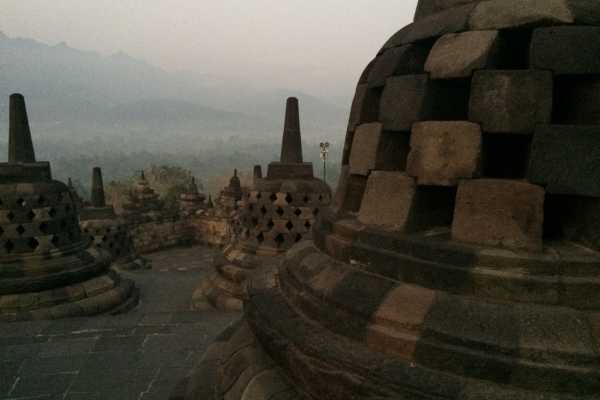
From the air, Borobodur forms a mandala – a geometric aid for meditation. From a distance on the ground, it’s a stupa.
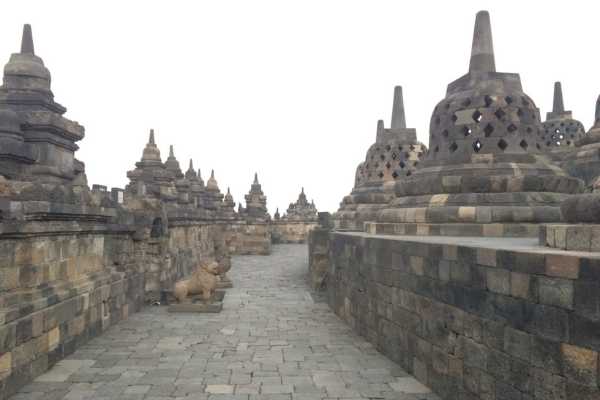
See Borobodur with Fewer People
It’s glorious. Especially in the pre dawn light that we’re sharing with about 60 other folks. Regular tickets are allowed in from 06:00, and they do start to trickle in at that point, but not in the hordes that we’d expected. Such is traveling in the off season.

The Buddhist Meaning behind Borobodur
The temple is loaded with Buddhist meaning – from the Jataka tales to the life of Prince Siddartha on his way to becoming the Buddha – there’s much more on that HERE.
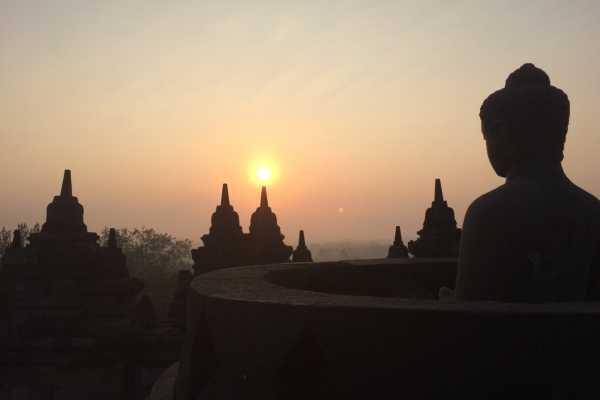
Despite the people it has the serenity of Sanchi, in India (which we visited with perhaps a dozen other people at the site), and it’s survived many attacks over the years.
There have been regular volcanic eruptions, the latest was in 2010, when 55,000 stone blocks had to be removed in order to repair the drainage system. It’s been bombed, by an opponent of Soeharto in 1985, when nine small stupas were damaged, but later fully restored.
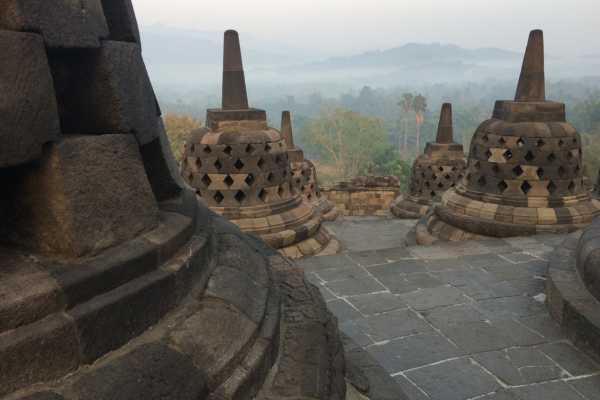
Visitors damage Borobodur
And it suffers from us and our visits. We can see it happen. Visitors clamber up and onto stupas for a better photo. On holidays more than 90,000 people visit each day. (yes, 90,000!) There’s a drone flying overhead.
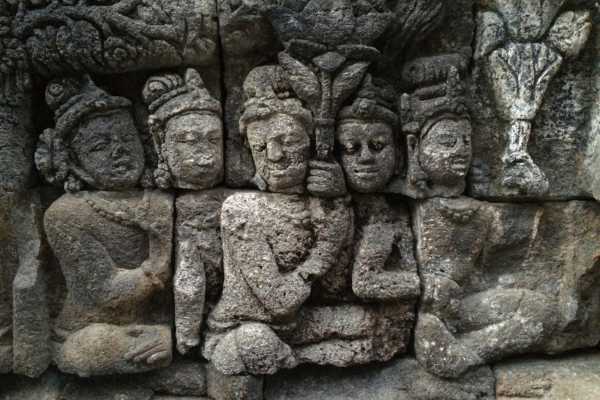
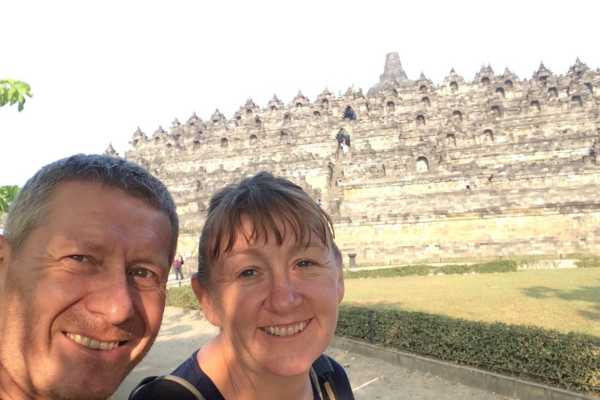
Our expensive sunrise ticket also includes a “snack” and tea and coffee at the Manodhaara Hotel, which we entered through, so coffee and a fried banana latter we’re waiting in the parking lot for the rest of our group, who opted for the cheaper sunrise option – watching the sunrise from a nearby hill, then entering the temple after 6am.

Joint Tickets for Borobodur and Prambanan
Doing it that way allows the purchase of a joint ticket (US$30) to also allow entry to the Prambanan Hindu Temples, which is where we’re heading next. Because folks who come to the actual temple for sunrise clearly aren’t trying to save money (I’m surmising, because I am at the temple for sunrise to see the temple without the hordes) there’s no joint (money saving) ticket available.
Prambanan
Prambanan is 17 km northeast of Jogja and a bum-numbing 90 minutes in our minivan from Borobodur. Prambanan is the best remaining example of Hindu development in Java.
It’s a frustrating ticket purchase of US$18, with a long line and a lack of any form of organization. You can pay with cash or buy your ticket to Borobodur and Prambanan with a credit card. A smart card purchased from a ticket window that is 2 meters away from the smart card entry smacks of over-investment in nonsense. And it’s now baking hot.
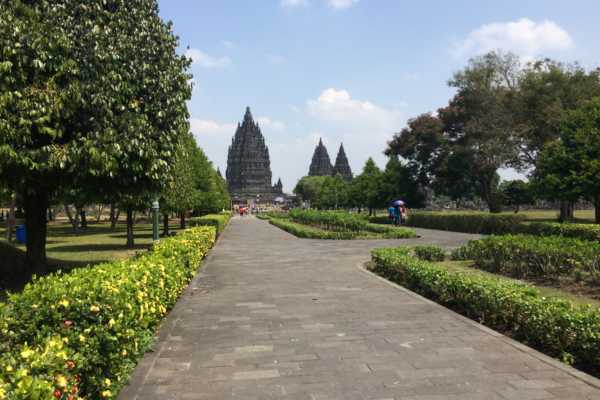
Prambanan History
50 years after Borobodur was built, the huge temple complex here at Prambanan was built, in the middle of the 9th century. It was to commemorate the return to sole power in Java of a Hindu dynasty.

The temples were in ruins for centuries, despite some efforts in 1885 to clear the sites. It wasn’t until 1937 that reconstruction was first attempted. Everywhere are piles of blocks.
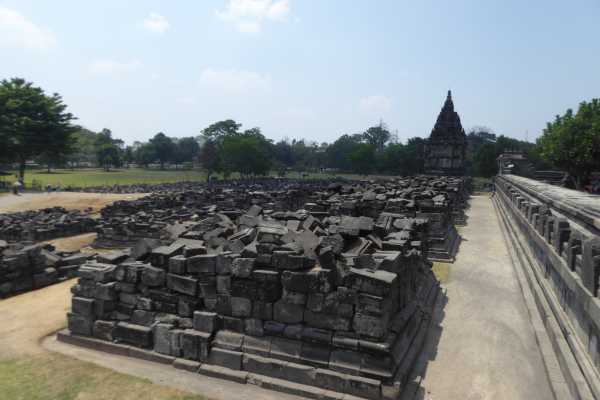
Prambanan Reconstruction
Even some of the reconstruction appears like a small child’s first efforts at Lego across the 244 temples that there are remains of here. The site is large, and walking is pleasant if you take it slow, but there’s a fair area to cover.
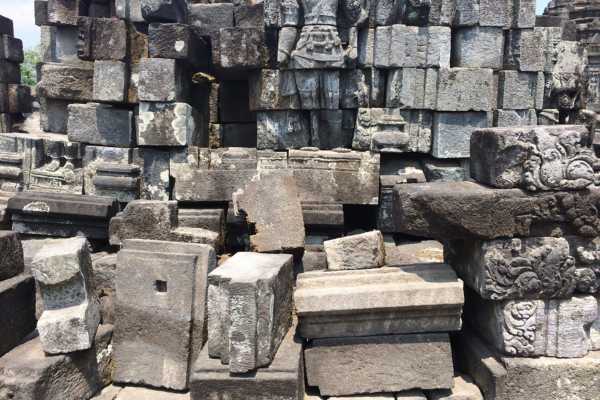
Prambanan – the Candi Shiva Mahadeva
In the central courtyard there are eight major and eight minor temples, the largest and the most decorative is Candi Shiva Mahadeva (the Shiva Temple). This main temple’s spire is 47 meters high and has small lions in niches flanked by trees of heaven.
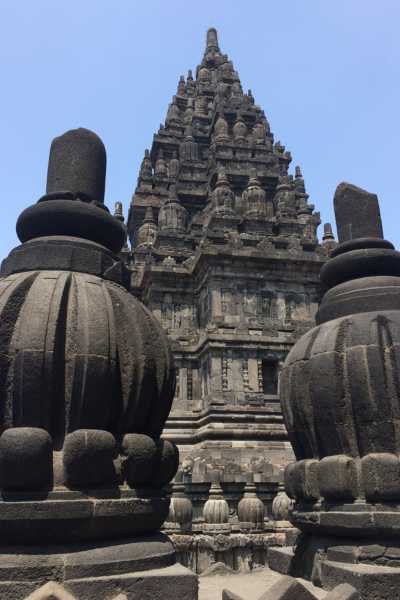
Here we find scenes from the Hindu epic, the Ramayana. It tells how Lord Rama’s wife, Sita is abducted and how Hanuman the Monkey God, and Sugriwa, the white monkey general find her and release her. It was this part of the Ramayana that we tried to see in the Kecak Fire and Trance Dance show in Ubud recently – but ended up watching most of the action through the folks in front’s camera.
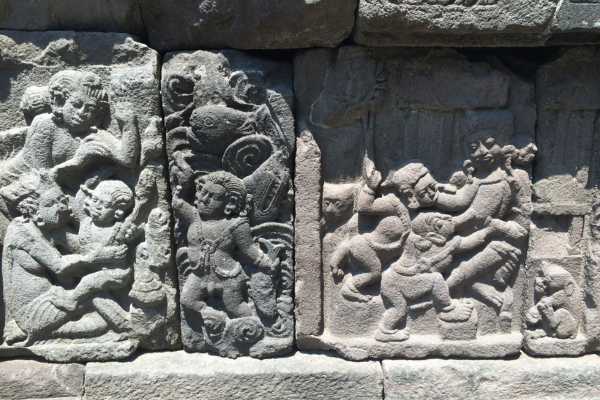
The 2006 Earthquake and Prambanan
It’s sad to see the reconstruction efforts here. While Prambanan was inducted to UNESCO World Heritage Status in 1991, an earthquake in 2006 sent hundreds of stone blocks to the ground – 479 of them at the Shiva temple.
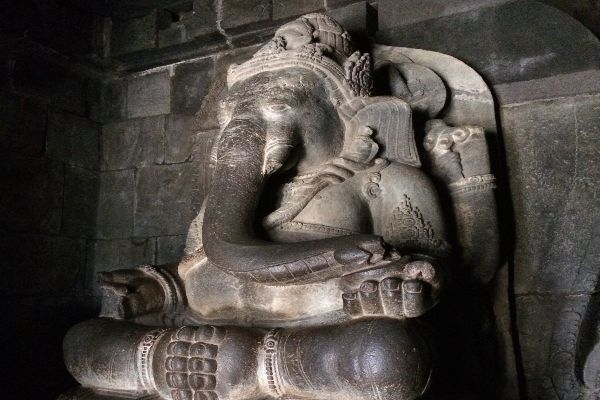
We’re sharing a van back to Jogja with an Eastern European couple, they’re here in Java for a few months, and this is their first Hindu temple.

They’re awed. They’re concerned that we’re disappointed. We explain that after five months of Hindu temples in India, we’re probably spoiled for life for other Hindu temples.
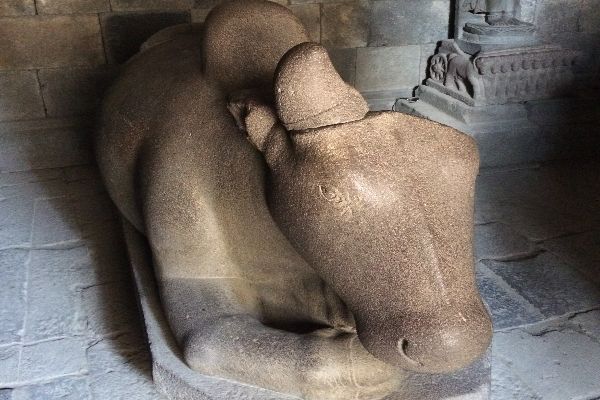
Travel Tips for Exploring Indonesia
- Get Travel Insurance: Civitatis includes medical expenses, repatriation, theft, luggage delays. No deductibles or upfront payments. Get a quote here.
- Get online immediately with an eSIM for Indonesia here
- Download and install a VPN BEFORE you travel to Indonesia > discount coupon here
- Save money in Indonesia with a Wise debit card
- Book the best tours and attractions in Indonesia
- With Klook
- Or with GetYourGuide
- Book Buses & Trains in Indonesia with Bookaway
- Book accommodation in Indonesia with Agoda
Back to Yogyakarta
Back in Jogja, we learn a key Bahasia Indonesian phrase I wish we could learn in every language. “Jalan, Jalan” – or “just walking around.”
Far from putting off each tuk-tuk driver we meet, it starts a conversation with “Oh so you speak Indonesian”. But, we have fun and Jalan Jalan around the dusty, busy streets.
We’ll be heading out by bicycle tomorrow because we’re going to visit a few sites, and then get out into the villages south of the city.
- Where we stayed in Yogyakarta – the Casa Raffles
- What to Eat in Indonesia
ASocialNomad is a participant in the Amazon Services LLC Associates Program, an affiliate advertising program designed to provide a means for sites to earn advertising fees by advertising and linking to amazon.com, amazon.co.uk, and amazon.ca. Amazon and the Amazon logo are trademarks of Amazon.com, Inc. or its affiliates. As an Amazon Associate, I earn from qualifying purchases.

